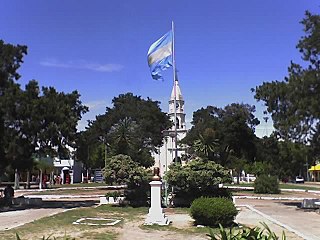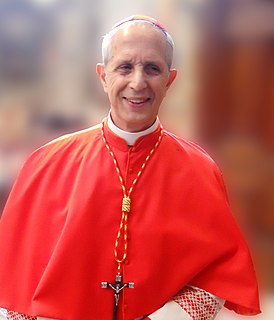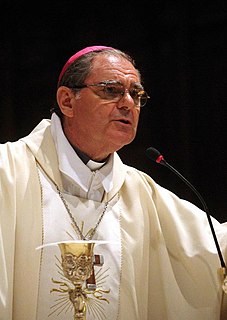
A partido is the second-level administrative subdivision only in the province of Buenos Aires, Argentina. They are formally considered to be a single administrative unit, usually contain one or more population centers, and are divided into localidades. The subdivision in partidos in Buenos Aires Province is distinct from all other provinces of Argentina, which call their second-level subdivisions departamento and are further subdivided into distinct municipalities.

Pilar is a city in the province of Buenos Aires, Argentina with a population of 299,077 as per the 2010 census [INDEC]. It is part of the Greater Buenos Aires urban conurbation and is the seat of the administrative division of Pilar Partido. Since the early 1990s, Pilar has gained an increasingly upscale profile due to the development of numerous gated communities, country clubs and polo fields.
Irish Argentines are Argentine citizens who are fully or partially of Irish descent. Irish emigrants from the Midlands, Wexford and many counties of Ireland arrived in Argentina mainly from 1830 to 1930, with the largest wave taking place in 1850–1870. The modern Irish-Argentine community is composed of some of their descendants, and the total number is estimated at 500,000–1,000,000.

Merlo is the head town of the eponymous partido of Merlo and seat of the municipal government, located in the Greater Buenos Aires urban area of Buenos Aires Province, Argentina.

Santiago Luis Copello was an Argentine Cardinal of the Roman Catholic Church. He served as Archbishop of Buenos Aires from 1932 to 1959, and was elevated to the cardinalate in 1935. Copello served as the first Argentine cardinal and the first cardinal from Hispanic America.

Ramallo is a town in Buenos Aires Province, Argentina. It is the administrative centre for Ramallo Partido. It is located on the Río Paraná.

Carmen de Areco is a town in Buenos Aires Province, Argentina. It is the administrative centre for Carmen de Areco Partido.

Carlos Mugica was an Argentine Roman Catholic priest and activist.

The Yellow Fever in Buenos Aires was a series of epidemics that took place in 1852, 1858, 1870 and 1871, the latter being a disaster that killed about 8% of Porteños: in a city where the daily death rate was less than 20, there were days that killed more than 500 people. The Yellow Fever would have come from Asunción, Paraguay, brought by Argentine soldiers returning from the war just fought in that country, having previously spread in the city of Corrientes. As its worst, Buenos Aires population was reduced to a third because of the exodus of those escaping the scourge.
Events in the year 1871 in Argentina.

Mario Aurelio Poli is an Argentine prelate of the Catholic Church who has served as the Archbishop of Buenos Aires since April 2013. He previously served as the Bishop of Santa Rosa from 2008 to 2013. Pope Francis, his predecessor in Buenos Aires, made him a cardinal in 2014.

Juan de Canaveris was an Piedmontese lawyer and politician, who served during the viceroyalty of Río de la Plata as accounting officer in the Tribunal de Cuentas de Buenos Aires. He had achieved a high social status in the Viceroyalty of the Río de la Plata, where he supported the revolutionary movements of May, being the only neighbor of Italian origin who attended in the Open Cabildo, of May 22, 1810.

Oscar Vicente Ojea Quintana is an Argentine prelate of the Catholic Church who has been bishop of San Isidro since 2011 after being named bishop coadjutor there in 2009. He was an auxiliary bishop of Buenos Aires from 2006 until 2009.
Juan José Canaveris (1780–1837) was an Argentine jurist and politician, who served as military man, lawyer, notary, prosecutor and accountant of Buenos Aires. In 1809 he was honored by the Junta Suprema de Sevilla, for his heroic participation in the defense of Buenos Aires, during the English invasions in the Río de la Plata.

Joaquín Canaveris was an Argentine attorney, merchant, politician and military man, who served as consignee in The Consulate of Buenos Aires. He had an active participation in the defense of Buenos Aires during the English invasions, serving as an Assistant in the battalion of Tercio de Vizcaínos.

Casimiro Alegre (1741–1825) was an Argentine politician and military man, who had an outstanding participation during the Viceroyalty of Peru and Viceroyalty of the Río de la Plata, serving as alcalde of campaign in the Province of Buenos Aires, and as Commandant in the Regiment of Blandengues of the Frontier of Buenos Aires.

Tomás Onésimo Canavery (1839–1913) was an Argentine Catholic priest and military chaplain, who served under the command of Bartolomé Mitre during the War of the Triple Alliance. He participated in most of the military actions against the Paraguayan forces, being promoted to lieutenant colonel in the same battlefield by order of General Juan Andrés Gelly y Obes.
The Ordinariate for Eastern Catholics in Argentina is a Catholic Ordinariate for Eastern Catholic faithful, jointly for all Eastern Catholics, regardless of rite, living in Argentina.

The Parish Church of Nuestra Señora de Montserrat is a Roman Catholic church in the autonomous city of Buenos Aires.

Parroquia Nuestra Señora de la Piedad of Temperley is a Catholic church located in the city of Temperley, south part of Greater Buenos Aires, Argentina.


















